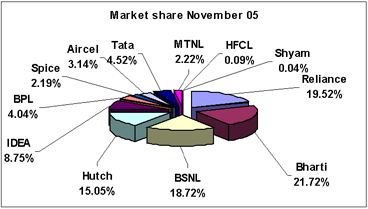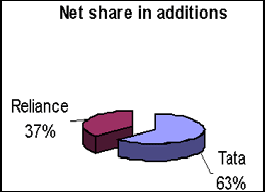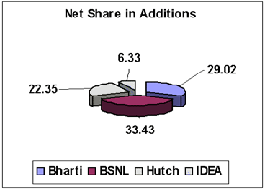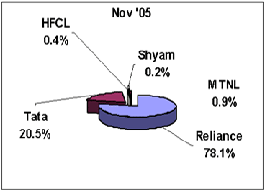Telecom: A Booming Industry
Global Telecom
Mobile phones, cable television, Internet, broadband connectivity, net telephony are just some of the many new technological innovations we take so much for granted today. Twenty years ago, many of these facilities were unthinkable. Over the years, from the then revolutionary telephone to today’s cutting-edge space communication systems, the global telecom industry has undergone a massive transformation.
Telecommunications is a large and dynamic business that continues to enjoy significant growth worldwide in past few quarters. Telecommunications is a mature industry that has been globally available for some time. Entry costs for new users and tariffs have been continuously reduced to increase subscriber numbers and minutes of use.
Competition is often already intense amongst the established players. The wireless telecommunications market has long been recognized as one of the most dynamic and fastest-growing segments of the global telecommunications industry, and worldwide is growing at a faster rate than wire line service. The uptake of wireless services in developing regions, and the ability to achieve reasonable wireless data rates, has resulted in unprecedented wireless services penetration and revenue growth. The overall telecommunication services market is expected to grow profoundly in the coming years lead by wireless and high-speed Internet services.
Telecom sector in India
The telecom sector is among the fastest growing sectors in our country today. Currently there are well over 45 million mobile users in India. And this number is growing very rapidly. Moreover, the broad-band/ digital cable is also now all set to take the country by storm. And over 47 million new lines are to be added in the coming years.
India is the seventh largest telecommunications market in the world with a wide range of services including basic, cellular, internet, paging, V-SAT, etc . Ernst & Young expects revenues from the Indian telecom sector to reach $23-25 billion by 2007. The growth of the Indian telecom sector is being driven mainly by competition and foreign investment, following government reforms in the mid-1990s. Recent regulatory reform provides further incentive for foreign investment in this sector.
With an investment of Rs. 1,60,000 crore in the Indian telecom space over the next two years and the doubling of its total subscriber base, India will emerge as the second most important communication market in the world. The total wireline and wireless subscriber base in India has zoomed from 4.8 million subscribers in 1992 to almost 100 million subscribers in 2005, with an expected further doubling of this figure in next three years. Broadband subscriber growth is likely to be at even faster rates as the market matures.
India ’s telecom sector has made spectacular strides over the last one decade. The entry of private sector operators has extended the network and brought in a variety of new value added services.
The number of service providers for fixed local services went up from 2 in the early nineties to 7 at the start of the decade. There are 12 cellular service providers, 72 internet service providers, and 9 V-SAT operators. Public call offices in India number 2.7 million and there are half a million village public telephones.
The most promising emerging technologies for the Indian telecom sector are the wireless broadband access technology WiMAX, Internet telephony, and software and content for mobile applications. With cities becoming increasingly saturated mobile markets, focus is shifting to the large rural segment. India is also becoming increasingly attractive as a destination for telecom equipment manufacturing, and outsourced research and development.
Telecom tariffs have fallen quite sharply over the last few years, due to increased competition and the falling cost of service. Mobile tariffs are expected to fall by 15-20 per cent annually over the next 2 years, driven by a decline in regulatory costs, greater economies of scale as a result of a further increase in the subscriber base, and keen competition among operators to garner a larger share of a growing market.
The growth of the telecom sector network is best indicated by the growth in teledensity. Teledensity initially went up from 0.02 per 100 population in 1948 to 0.60 per 100 population in 1991. Teledensity rose over to 1.07 in 1995, 2.33 in 1999, 3.53 in 2001, 4.29 in 2002 and to 5.11 in 2003. It has risen by 2 percentage points in each of the last two years to 7.08 in 2004 and to 9.13 in April 2005. The tele-density is expected to grow up to 15 by 2010.
Table-1: Growth of the Telecommunication Network (in million) |
|
Fixed line (including WLL fixed) |
Cellular mobile phones (including WLL mobile) |
Total phones |
1996-97 |
14.5 |
0.3 |
14.9 |
1997-98 |
17.8 (3.3) |
0.9 (0.5) |
18.7 (3.8) |
1998-99 |
21.6 (3.8) |
1.2 (0.3) |
22.8 (4.2) |
1999-00 |
26.8 (5.2) |
1.9 (0.7) |
28.7 (5.8) |
2000-01 |
33.0 (6.2) |
3.6 (1.7) |
36.6 (7.9) |
2001-02 |
39.1 (6.2) |
6.4 (2.9) |
45.6 (9.0) |
2002-03 |
41.5 (2.4) |
13.0 (6.6) |
54.5 (8.9) |
2003-04 |
42.6 (1.1) |
33.6(20.6) |
76.2(21.7) |
2004-05 |
45.9 (3.3) |
52.2(18.6) |
98.1(21.9) |
2005-06# |
47.2(1.3) |
59.8 (7.6) |
107.0 (8.9) |
Note: # =April-July |
|
Key players in the market
The government players include the Department of Telecommunications of India’s Union Ministry of Communications and Information Technology, and the Telecom Regulatory Authority of India (TRAI). The ministry sets telecom policy, and TRAI is the statutory regulator.
The state-owned service providers BSNL and MTNL also play a major role in India’s telecom sector. Reforms in 2001 and resulting competition have led to the erstwhile monopolies offering GSM/CDMA cellular services and Internet services to stay competitive. Together, BSNL and MTNL account for 97 per cent of India's fixed-line subscriber base.
The two companies’ combined plan is to have at least a million broadband subscribers by the end of the year and four million by the end of 2006. The “Broadband Policy, 2004” seeks to accelerate the growth of broadband and internet services. The target is to establish a broadband subscriber base of 20 million by 2010.
Videsh Sanchar Nigam Limited (VSNL) is India’s biggest provider of international voice and data services. Privatised in 2002, VSNL is now part of Tata Group, which owns about 45 per cent equity stake.
Private players include:
- Bharti Televentures Ltd
- Bharat Sanchar Nigam Ltd.
- Hutchison Max Telecom Ltd.
- Mahanagar Telephone Nigam Ltd.
- Reliance Infocomm Ltd.
- Tata Teleservices Ltd.
- Videsh Sanchar Nigam Ltd.
R & D and trade in telecom sector
Local companies, joint ventures with international players, and subsidiaries of MNCs are involved in telecom software of the embedded, system, and application varieties. Big software companies such as Infosys Technologies, Satyam Computers and Wipro develop telecom software, and companies such as Hughes Software and Sasken have this exclusive focus. Several MNCs, including Alcatel, Cisco, Ericsson, Lucent Technologies, and Nortel, have established subsidiaries or research collaborations, or have outsourced R&D to Indian companies.
India imported over $5 billion worth of telecom equipment in 2004. Indian firms manufacture some customer premises and carrier equipment, but most state-of-the-art equipment – including mobile handsets -- is still exported.
Investment policies in telecom
In February 2005, the Indian government raised the cap on foreign investment 49% to 74% for Indian telecom service providers like basic, cellular, unified access services, national and international long distance, V-SAT, Public Mobile Radio Trunked Services (PMRTS), Global Mobile Personal Communications Services (GMPCS) and other value-added services. Analysts expect the policy decision to spur investment, which could result in initial public offerings from many Indian telecom providers, as well as pay for sufficient telecom equipment for telecom expansion in the booming Indian market. However, FDI cannot exceed 49 % and the management has to be in the hands of the Indian owners.
Indian regulations have opened up all segments of the telecom sector to private players, legalized Internet telephony, relaxed broadband regulations, and created incentives for foreign investment in the sector. This has resulted in the entry of several private equipment and service providers, vigorous competition, affordability and increased coverage.
Landmarks
April 2005 was a historic month for the Indian telecom industry with the total subscriber base crossing the 100million mark.
July 2005 was a landmark for the telecommunication sector in a number of ways. The size of the private sector telecom network has now become larger than that of the public sector network for the first time. The telecom network in the private sector stood at 53.76 million in end-July 2005 while that of the public sector operators was 53.24 million adding to a total of 107 million phones.
Current telecom statistics
|
September’ 05 |
October’05 |
November’05 |
Total subscribers |
112.88mn |
116.12mn |
119.9mn |
Tele-density |
10.38 |
10.66 |
11.00 |
Fixed line |
47.83mn |
48.17mn |
48.47mn |
Additions during the month |
0.39mn |
0.34mn |
0.28mn |
Mobile |
65.05mn |
67.95mn |
71.46mn |
Total additions during the month |
2.48mn |
2.90mn |
3.51mn |
GSM additions |
1.96mn |
2.11mn |
2.32mn |
CDMA additions |
0.52mn |
0.79mn |
1.18mn |
Mobile telephony services are rapidly expanding and have contributed approximately 92% to new subscriber additions in November 2005. The segment’s subscriber base grew a record 5.1% mom to 71.46mn. Of the total subscriber’s added, almost 66% subscribers belonged to the GSM segment and the rest were CDMA segment.
Market share of mobile subscribers

India 's GSM mobile operators added record 2.32mn subscribers in the month of November. The highest ever addition since inception of service was largely due to falling handset prices and lower priced coupons (Rs200). The total GSM subscriber base increased by 4.39% to 55.3mn
GSM subscribers
Group Company |
Subscribers as of October'05 |
Additions In Nov |
Subscribers as of November'05 |
(%)Growth |
Bharti |
14,740,366 |
675,636 |
15,416,002 |
4.58 |
BSNL |
12,510,826 |
778,259 |
13,289,085 |
6.22 |
Hutch |
10,162,157 |
520,357 |
10,682,514 |
5.12 |
IDEA |
6,062,722 |
147,450 |
6,210,172 |
2.43 |
BPL |
2,849,088 |
19,055 |
2,868,143 |
0.67 |
Spice |
1,518,768 |
34,803 |
1,553,571 |
2.29 |
Aircel |
2,169,509 |
59,067 |
2,228,576 |
2.72 |
Reliance |
1,607,911 |
15,940 |
1,623,851 |
0.99 |
MTNL |
1,365,988 |
77,358 |
1,443,346 |
5.66 |
Total |
52,987,335 |
2,327,925 |
55,315,260 |
4.39 |
GSM market share GSM share of net additions
 
CDMA subscriber’s base grew to a record 15.66mn with Tata contributing a chunk of additions in subscriber base.
CDMA subscriber data
Group Company |
Subscribers as of October'05 |
Additions In Nov |
Subscribers as of November'05 |
(%)Growth |
Reliance |
11,781,366 |
448,054 |
12,229,420 |
3.8 |
Tata |
2,479,130 |
728,552 |
3,207,682 |
29.4 |
HFCL |
60,834 |
948 |
61,782 |
1.6 |
Shyam |
28,225 |
(260) |
27,965 |
(0.9) |
MTNL |
143,005 |
(9,610) |
133,395 |
(6.7) |
Total |
14,492,560 |
1,167,684 |
15,660,244 |
8.1 |
Market share of CDMA operators CDMA share of net additions
 
|

